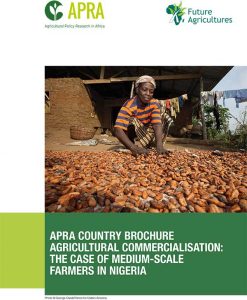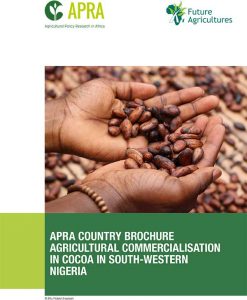The output of the work and research conducted in Nigeria under APRA is shared below. You can also download it in PDF form with direct links to related papers and publications.
RESEARCH
Contact Person: Adebayo B. Aromolaran | adebayo.aromolaran@gmail.com
Agricultural Commercialisation: The Case of Medium-Scale Farmers in Nigeria
APRA is working in Nigeria to: document the pace at which farm size distributions are changing in Nigeria, with particular focus on the rise of medium-scale farmers and their influence on agricultural commercialisation; assess the causes and consequences of changing farm size distributions in Nigeria; characterise the potentially diverse pathways through which individuals become commercialised medium-scale famers; explore whether medium-scale farmers are making small-scale farmers more productive and commercialised; and examine the differing outcomes of various agricultural commercialisation pathways.
-
Research objective
This study examines two major pathways into commercialised medium-scale farming in Nigeria: ‘farm-led’ or ‘stepping up’, which involves small-scale farms (SSFs) acquiring additional land and expanding into medium-scale farms (MSFs); and ‘non-farm income led’ or ‘stepping in’, which involves lateral entry into medium-scale farming by investors who were previously engaged in non-farming jobs.
The objective is to discover whether MSFs should be promoted as a pathway to agricultural commercialisation in Nigeria. It investigates the characteristics of MSFs, the process that produces them, their relative importance in the agricultural commercialisation process, the relationship between increasing scale and productivity, and whether they influence the behaviour and welfare of the millions of SSF households around them.
-
Study questions
1. What are the characteristics of the changing farm structure and the emerging MSFs?
2. How do MSFs influence the behaviour and welfare of the millions of SSF households around them?
3. Are there productivity differences between SSFs and MSFs?
4. Do conflicts significantly impact the ability of SSFs to transition to larger scales?
5. What role does resilience play in mitigating the effects of conflict shocks on the ability of farmers to expand their land holdings?
6. What are the major drivers of agricultural commercialisation, and how do their effects differ between SSFs and MSFs?
7. Are there differences in the welfare of MSF households compared to SSF households?
8. Should medium-scale investor farms be promoted as a policy tool to promote agricultural commercialisation and transformation?
-
Findings
1. Supporting the growth of MSFs could provide an important pathway to increased agricultural commercialisation, leading to significant positive welfare implications for SSF households.
2. Small- to medium-scale farming transitions have been occurring very slowly and policy should focus on accelerating the process.
3. Enhancing direct entry into medium-scale farming by investor farmers is an important pathway to agricultural commercialisation, so should receive increased policy attention.
4. Important drivers of agricultural commercialisation in Nigeria were found to include: increased access to labour and land markets; better land tenure security; extension services; all-weather roads; new investment in agricultural products markets and agro-dealer services; and better transport services.
5. Increased productivity is associated with an increased scale of operation, especially on stepped up farms over 11 ha and stepped in farms over 30 ha in size. Consequently, the growth of MSFs improves the livelihoods of farm households by increasing wages and returns to family labour.
6. Growth of MSFs could significantly impact smallholder input use, yields, and prices through positive knowledge spill-over and coordination effects. Specifically, the activities of MSFs help improve SSF household productivity and welfare through improved management practices and opportunities to sell their output at more competitive prices. Due to the substantial marketed surpluses grown by MSFs, areas possessing a high concentration of this group attract new private investment in crop buyers, which improves market access conditions for SSFs. As such, policies that encourage the coexistence of MSFs and SSFs should be supported.
7. Shocks, such as conflicts and drought, hinder the ability of farmers to transition to medium- or largerscale farms. However, factors such as education, assets, social safety nets, and off-farm income help mitigate the harmful effects of shocks on their ability to expand.
8. Women and youths are less likely to allocate larger shares of their farmland to commercial tree crops compared to arable crops.
9. Land availability, road infrastructure, and input and output market access are key factors in facilitating the transition of SSFs to MSFs. Promoting wellfunctioning land markets would play an important role in the direct establishment of commercialised MSFs.
10. The rise of MSFs contributes to increased agricultural commercialisation and the development of agricultural output and factor markets. However, the growth of MSFs may also result in raised land prices, which would restrict potential area expansion by small-scale farmers in land deficit areas.
-
Conclusion and policy messages
Based on the findings of this APRA analysis under Work Stream 1, certain policy actions could enhance agricultural commercialisation and livelihood outcomes among SSF households in Nigeria. These include:
- Increasing land tenure security to facilitate land sales and rental markets, while protecting the rights of smallholder farmers.
- Enhancing public investment in rural infrastructure to stimulate private investment on the farm, in input distribution systems, and in downstream agri-food systems.
- Improving the functioning of public agricultural research and development and extension systems to promote productivity-enhancing technical innovations.
- Supporting complementary private extension systems, which could be primarily effective in high potential farming areas.
- Relaxing the cultural and economic constraints faced by women and youths in acquiring land for the cultivation of commercial tree (permanent) crops.
- Improving environment security and resilience factors, such as education access, asset holdings and off-farm income, and access to social safety nets, to enhance commercialisation among existing small farm households and enable greater positive synergies between MSFs and SSFs.
Agricultural commercialisation in cocoa in South-Western Nigeria
APRA is working to: examine how the economy and livelihoods have changed in relation to cocoa; determine if there has been a movement towards greater intensification on smaller land areas; assess the impact of cocoa cultivation on food crop cultivation; and explore the role of technology in cocoa commercialisation.;
-
Research objective
This study aims to look into historical trends and quantitative information regarding the interaction of cocoa with the market (commercialisation), farmers’ wellbeing, and the influence their wellbeing levels have on rural transformation.
It will also investigate drivers of change and cocoa commercialisation in Nigeria, focusing on:
a. different livelihood trajectories, including changes in cropping systems, land, labour, natural resources and social relations;
b. historical pathways and the dynamics of change within cocoa production in relation to patterns of migration, accumulation, and dispossession; and c. how the economy and livelihoods changed in relation to cocoa.
-
Study questions
• What impact has cocoa had on the economy and livelihoods?
• What types of relationships do farmers have with the market (i.e. their level of commercialisation), focusing on both inputs and outputs?
• What are the processes and determinants of stepping in, stepping out, stepping up, hanging in, and dropping out of the cocoa sector? Is capital accumulation converted into other enterprises, including investments back into cocoa, other crops, or non-farm activities (e.g., investment into education and conversion of cocoa wealth into non-farm professions; investment in trade and transport), or does it decline and dissipate?
• What impacts do the global cycles of boom and recession, and the opening up of new areas of cocoa, have on production in Nigeria?
• What has been the influence of cocoa commercialisation on farmers’ livelihoods, particularly on income, food security, nutrition, poverty, productivity, and women empowerment?
• What are the challenges and prospects of further cocoa production in Nigeria?
• What are the changing gender roles and livelihood outcomes for women, men, and youth
-
Findings
• Changes in the economy and livelihoods are evident, as the majority of farmers have shifted their focus to other crops such as oil palm because it is cheaper to cultivate, and less cumbersome.
• An increase in cocoa production has been constrained by limited access to land, inputs and high labour costs, attacks by Fulani herdsmen, poor cocoa yields (in both quality and quantity), poor infrastructure, and inadequate access to financial services. COVID-19 restrictions have also exacerbated economic losses for both farmers and exporters.
• Indigenes who own cocoa farms hand them over to migrant labourers on a complete sale or lease arrangement because they are either too old or busy to dedicate time and other resources to it.
• From an input perspective, the level of commercialisation of cocoa farmers is low indicating that farmers’ access to inputs, such as seed through the market, is low.
• Cocoa commercialisation plays an important role in contributing to food security and lowering poverty levels, as it provides the majority of farmers with enough income to cover their monthly expenditures (both food and otherwise). Despite this, most farmers are deprived in at least one studied indicator (i.e., health, nutrition, living standards); as such a high number are multi-dimensionally poor.
• Based on dietary diversification, the majority of farmers are food secure – although women enjoy more diversification in their meals.
• Household decision-making is led by males. However, women’s involvement in intra-household decision-making is relatively high.
• There are varying degrees of involvement in cocoa production between male and female farmers.
• Young adults are migrating to urban centres, and as such are not very involved in the cocoa value chain.
-
Conclusion and policy messages
The level of cocoa commercialisation is generally low – even though farmers produce for the market and generate enough income to cover both food and nonfood expenditure of their households. Interactions with the input market is low because it is poorly developed; the input market contributes to high poverty levels because low quality inputs reduce yields and profits. Although women participate actively in household cocoa farming activities, production and marketing decisions are mostly made by men. This may be connected with socio-cultural values and the fact that cocoa is considered a ‘male’ crop.
Despite this, cocoa commercialisation contributes to rural transformation through its positive effects on households’ income, food security and poverty.
Policy recommendations
- Conduct gender-sensitive and context-specific research to better understand women’s disposition towards cocoa production.
- Develop subsidy mechanisms for farmers around inputs, such as agrochemicals and fertilisers, to enhance commercialisation.
- Create agricultural pricing policies, such as standardised pricing for cocoa and/or guaranteed financial support for actors along the value chain.
- Establish an all-encompassing agricultural input policy which would entail quality assurance, availability, access and knowledge support in its utilisation.
- Devise a rural infrastructure development policy to support input market development and curb rural-urban migration to enhance commercialisation and reduce poverty and food insecurity
- Create land policies to support and strengthen ownership, control, and access to land for youth.
- Develop a rural entrepreneurship development policy to strengthen rural people’s organisations to take advantage of business opportunities and aid in the development of local value chains.
- Farmers need to be sensitised on the importance of agricultural insurance and it should be made readily available to farmers for a reasonable cost, with an easy claims process, and pay-outs need to be swift.



